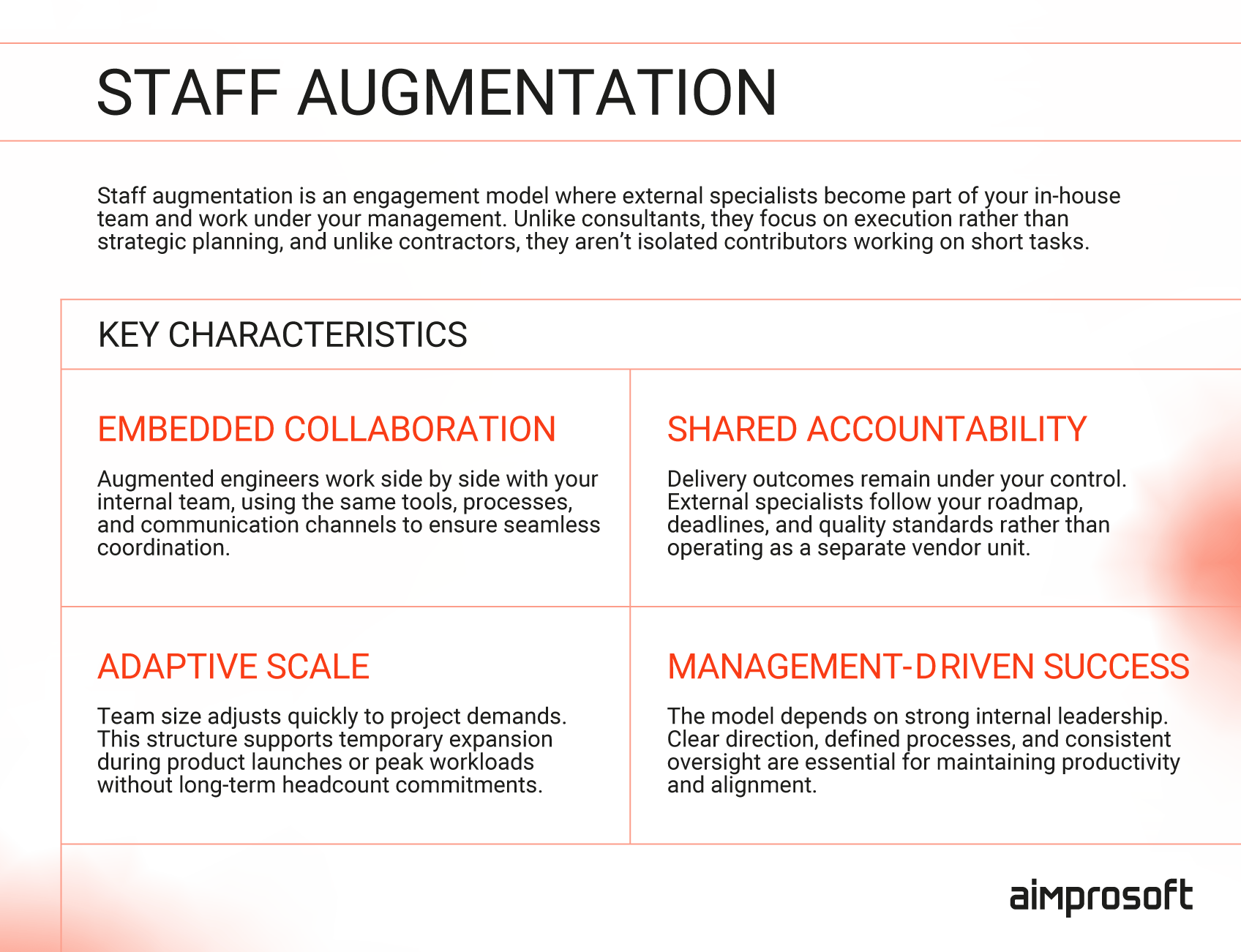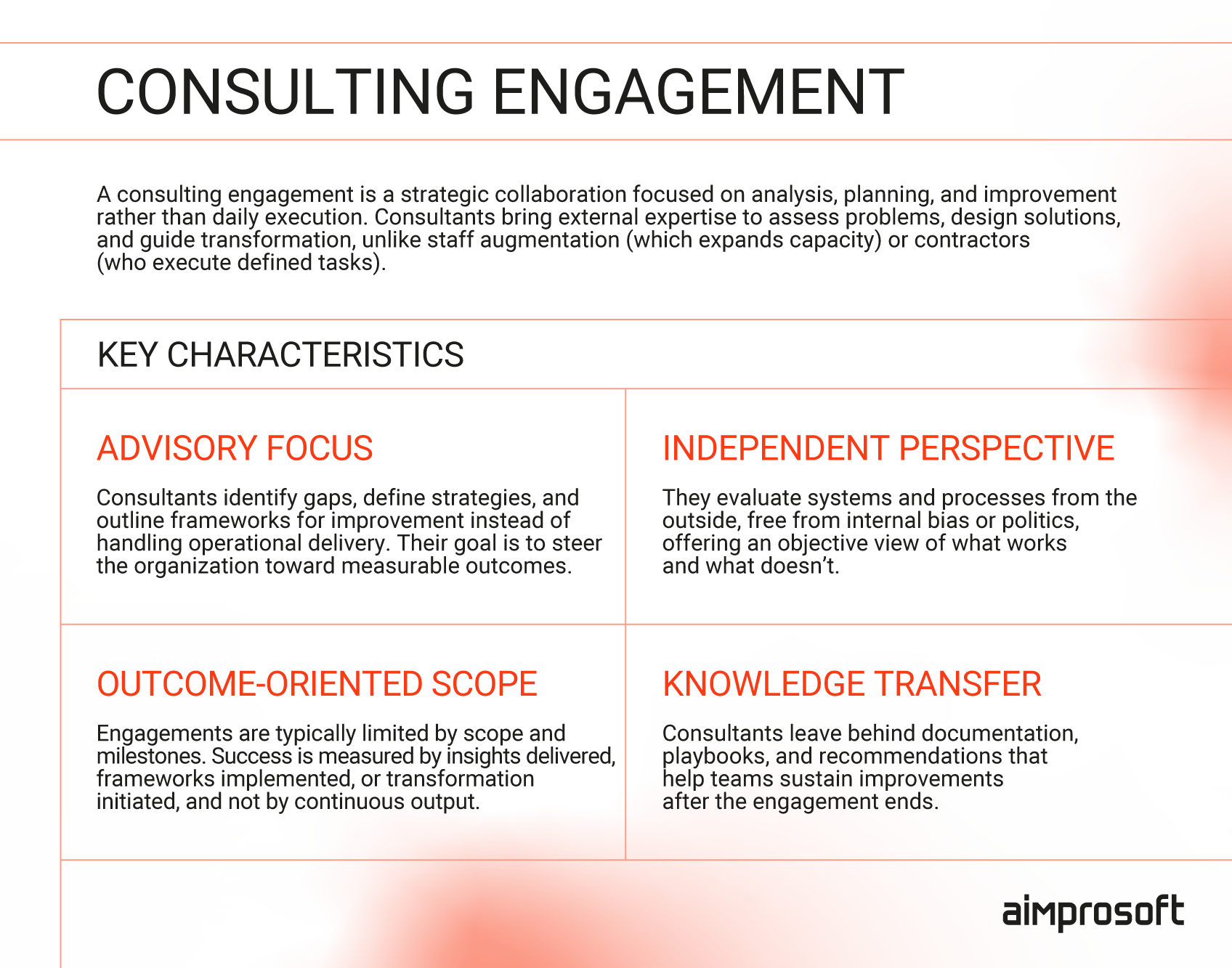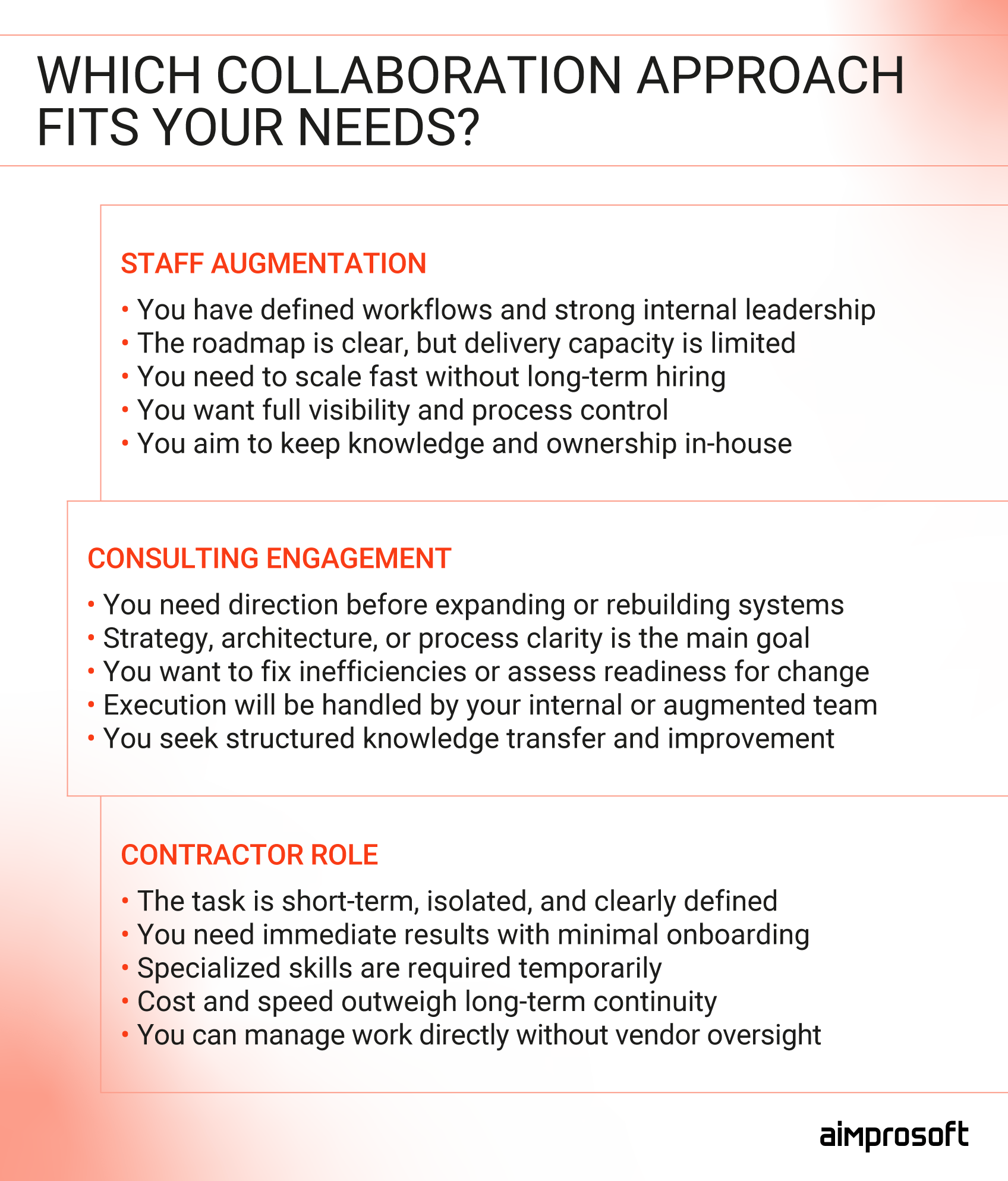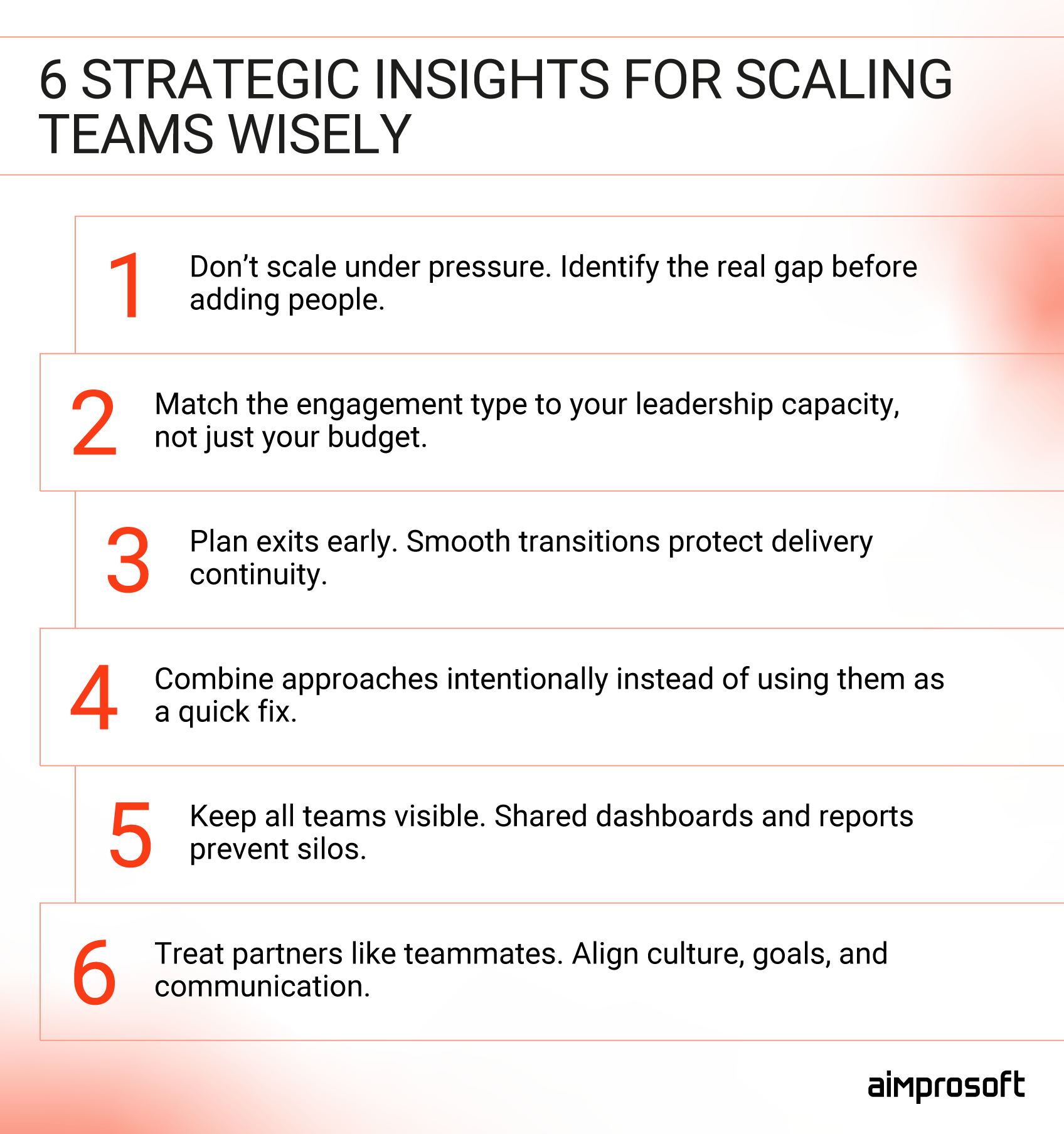Staff Augmentation vs Consulting vs Contractors: A Decision Matrix for Growing Teams
What is the best way to bring in external expertise, while balancing speed, cost, and control? Should you expand your team through staff augmentation, bring in consultants for guidance, or hire contractors for short-term results? Each approach looks practical at first, yet hidden friction is usually discovered later: blurred accountability, slow onboarding, or knowledge loss once the contract ends.
In our previous article, we compared staff augmentation, outsourcing, and managed services — three distinct collaboration models that define who owns delivery and outcomes. This time, we go a level deeper. Instead of comparing staffing models, we focus on the roles and engagement types companies use within those models: staff augmentation vs consulting vs contracting. We’ll help you recognize how each functions in practice, where it fits best, and when it’s time to shift from one to another.
Placing staff augmentation, consulting, and contracting in context
Before we compare consulting vs contracting vs staff augmentation, it’s important to define how they differ in scope. These terms often overlap in conversations about team scaling, but they operate at different levels. Staff augmentation is a model, while consulting and contracting describe roles or types of engagement. We’ll look at them here through one lens, namely, how each helps companies access external expertise while keeping delivery efficient and under control.
- Staff augmentation — a structured hiring model for integrating external professionals into your team. They follow your management and workflows, expanding capacity without changing ownership or processes.
- Consulting — an advisory or implementation role focused on diagnosing problems, designing solutions, and guiding teams through change rather than handling day-to-day delivery.
- Contracting — a task- or project-based engagement where independent specialists deliver defined outcomes quickly, often without deep integration into your operations.
In any outsourcing models comparison, it’s clear that each approach serves a specific purpose and brings its own balance of speed, control, and accountability. Let’s start with staff augmentation, the model that offers the highest level of operational oversight.
Staff augmentation: scaling fast while staying in command
What it means
Staff augmentation means bringing external professionals into your in-house team to fill skill gaps or boost capacity. They work under your management, follow your processes, and use your tools. The vendor provides talent, but you keep day-to-day control. It’s an approach built for flexibility, meaning you can scale fast without long hiring cycles.

Staff augmentation
When it works best: scenarios
Staff augmentation fits companies that already have solid internal management and clear delivery frameworks.
- A scaling SaaS company needs more developers to keep up with product growth.
- An enterprise wants to expand its QA coverage for a short release cycle.
- A team lacks a few specialists for a specific technology stack but wants to manage delivery internally.
It’s most effective when you can integrate new people smoothly and maintain consistent standards across permanent and external staff.
Benefits of staff augmentation
Full operational control. You retain authority over priorities, workflows, and delivery pace. External professionals work as part of your existing structure, following your management rules and engineering standards. This ensures alignment with your internal culture and long-term roadmap.
Rapid scaling without hiring overhead. Vendors maintain a ready talent pool, allowing you to expand teams in weeks instead of months. You avoid lengthy recruitment, onboarding, and HR procedures while still integrating people directly into your environment.
Access to niche skills on demand. Augmentation lets you bring in rare expertise temporarily, such as DevOps engineers, data scientists, or Liferay specialists, without long-term headcount commitments. This is especially useful when a project requires a short-term boost of specialized knowledge.
Budget flexibility. You pay only for the hours and expertise used. There are no recruitment costs, long-term benefits, or idle time expenses typical for full-time hires. This makes it easier to manage budgets during high- and low-load periods.
Knowledge retention. Unlike outsourcing or short contracts, augmented staff share the same environment and tools as your core team. They contribute to documentation and code repositories, allowing valuable knowledge to stay inside the company after the engagement ends.
Challenges and hidden costs
Management overhead. While augmentation gives control, it also requires it. Your internal managers remain responsible for assigning tasks, tracking progress, and ensuring collaboration across mixed teams. Without clear leadership, productivity and communication can drop quickly.
Integration and onboarding time. External specialists need context: workflows, access, and team dynamics, etc. If onboarding is rushed or undocumented, the early performance dip can offset the time savings promised by augmentation.
Cultural and communication gaps. Augmented engineers may come from different backgrounds or time zones. Misaligned communication habits, tool preferences, or language nuances can slow delivery unless properly managed.
Dependency on vendor talent supply. If your vendor’s pool becomes limited or turnover occurs, replacement time can disrupt project continuity. Relying heavily on one provider without backup options can expose teams to unexpected downtime.
Blurred accountability. When internal and external staff share the same board but report to different entities, ownership of results can become unclear. This often leads to tension during sprint reviews or performance assessments if roles and responsibilities were not set from day one.
Cost spillover during transition. Ending or scaling down augmentation usually requires handover time, knowledge transfer, and documentation updates. If not planned early, this phase can add unbudgeted hours and slow the transition to the next model.
Exit and shift strategies
Staff augmentation can evolve in two directions. Mature teams often move toward a hybrid model, keeping strategic ownership in-house while handing off execution to trusted partners. Others transition to managed delivery, where the vendor not only provides people but also leads processes and outcomes.
If you’re planning such a transition, use a staff augmentation decision matrix to evaluate when it’s time to shift models. It helps compare factors like control, scalability, and long-term cost to ensure changes happen for the right reasons. When you decide to scale down, knowledge transfer becomes key: document workflows early, maintain shared repositories, and plan gradual offboarding instead of abrupt handovers. The smoother the exit, the less risk you carry into your next growth phase.
Worried about legal or IP risks when scaling your team through augmentation? Discover how to protect your company and talent in our co-employment and IP guide.
Consulting engagements: gaining direction before adding speed
What it means
Consulting brings in external experts to analyze, advise, and sometimes implement solutions that improve your systems, processes, or strategy. Unlike staff augmentation, consultants don’t just join your workflow; instead, they reshape it. Their role is to diagnose problems, design improvements, and guide your team toward a clear, measurable outcome.

IT consulting engagement
When it works best: scenarios
Consulting fits when you need clarity more than capacity.
- You’re planning a system modernization or migration and need architectural guidance before development begins.
- Your delivery pipeline shows bottlenecks, but you’re unsure whether the issue is in code, process, or structure.
- You want to adopt new technology, such as AI or cloud-native systems, but lack the expertise to evaluate tools or ROI.
It’s best suited for organizations ready to challenge existing assumptions and invest in improvement rather than immediate execution.
Benefits of consulting
Strategic clarity and direction. In the comparison of outstaffing vs consulting vs contracting, consulting stands out for providing strategic clarity and direction. Consultants bring the high-level perspective often missing inside the organization, helping define long-term architecture, delivery frameworks, and technology choices before the first line of code is written.
Objective outside insight. An external consultant isn’t bound by internal politics or legacy decisions. They can identify inefficiencies, weak spots, and cultural friction that insiders often overlook.
Faster problem diagnosis. Experienced consultants have seen similar challenges across industries. Their accumulated expertise allows them to spot patterns quickly, reducing the time it takes to move from “we have a problem” to “we know what to fix.”
Structured knowledge transfer. A good consulting engagement leaves behind playbooks, roadmaps, and process documentation your team can reuse. The organization becomes more self-sufficient even after the consultants step away.
Cost control through prevention. Consulting may appear expensive at first, but it often prevents costlier mistakes, such as failed migrations, rework, or misaligned technology investments.
Challenges and hidden costs
Limited execution capacity. Consultants advise and sometimes prototype, but they rarely handle full-scale implementation. Without a capable in-house or augmented team, their recommendations may remain unexecuted.
Dependence on external expertise. When consultants drive major decisions, internal teams can become passive. If the handover isn’t properly managed, the organization may lose the ability to sustain improvements independently.
Scope drift during discovery. In the context of IT staffing vs consulting vs contracting, consulting projects often carry the highest risk of scope drift during discovery. They usually start with open-ended exploration, and without clear goals or timelines, the discovery phase can expand far beyond the original intent, consuming both time and budget.
Misaligned expectations. Sometimes consultants are expected to deliver outcomes, not insights. If roles aren’t clearly defined (who advises, who executes, who owns results) frustration builds quickly.
Hidden transition costs. Implementing consultant recommendations requires additional resources. New tools, training, or process shifts add indirect costs that should be planned upfront.
Exit and shift strategies
The best staff augmentation consulting engagements end with internal ownership. Plan early how insights will be transferred to your team, such as through documentation, shadowing, or workshops. Many companies move from consulting to staff augmentation once the roadmap is clear and execution begins. Others evolve into hybrid models, where consultants remain on retainer for periodic audits while internal or augmented teams handle daily delivery. A smooth exit happens when your team no longer needs direction to move forward and only focuses on delivering.
Contractor roles: agility for short-term and specialized needs
What it means
Contractors are independent professionals or small teams hired to complete specific, well-defined tasks. They operate outside your organization’s structure, usually under short-term contracts focused on deliverables rather than ongoing collaboration. When you hire international contractors, you manage their output but not their process. This model gives speed and flexibility but comes with limited visibility and long-term stability.

Independent contractor engagement
When it works best: scenarios
Contracting is most effective when your needs are clear, short-lived, and don’t justify a full-time role.
- You need a designer or developer for a quick proof of concept.
- A legacy system requires a one-time migration or integration fix.
- You need short-term technical expertise to support a peak workload or pilot a new idea.
It’s also a common choice for early-stage startups that need fast results before committing to a permanent team.
Benefits of contractors
Immediate access to expertise. Contractors can join quickly, often with minimal onboarding. Their experience in short engagements allows them to deliver results fast and adapt to new environments with little friction.
High flexibility. You can scale engagement up or down instantly, depending on workload. Contractors are paid for results or time spent, with no long-term employment obligations.
Specialized skill coverage. Contractors often bring deep expertise in narrow domains, from performance tuning or UI design to system configuration, which can fill a temporary gap without changing team composition.
Lower short-term cost. When comparing contractor engagement vs consulting vs staff augmentation cost, contractors typically have the lowest short-term expenses. For small or temporary tasks, they’re cheaper than hiring permanent staff or engaging a vendor through structured augmentation or consulting. You also avoid HR, benefits, and administrative costs tied to employment.
Reduced commitment risk. When you need to test an idea, validate technology, or deliver a one-off project, contractors let you do it without locking into a longer contract or building new management layers.
Challenges and hidden costs
Limited accountability. Contractors deliver tasks, not outcomes. Once their work is complete, continuity and maintenance become your responsibility. Without proper documentation, follow-up work often requires redoing parts of the job.
Inconsistent quality control. Since contractors work independently, enforcing your coding standards, QA practices, or documentation style can be difficult. This can lead to uneven quality across projects or integrations.
Knowledge loss after delivery. Once the contract ends, contractors usually move on to other projects. Without structured handovers, critical knowledge leaves with them, from system logic to deployment nuances.
Management overhead and fragmentation. Hiring multiple contractors for different roles may seem efficient, but quickly turns chaotic. Each operates independently, requiring separate coordination, feedback, and progress tracking.
Legal and compliance exposure. Depending on the jurisdiction, relying heavily on contractors can raise co-employment or misclassification risks. If they perform core functions under your direction long-term, legal boundaries can blur.
Hidden time cost. Even short engagements require sourcing, vetting, and onboarding. When repeated often, this cycle erodes productivity and offsets initial cost advantages.
Exit and shift strategies
When contractor reliance grows beyond isolated tasks, it’s a signal to transition to a more structured model. Companies often move toward staff augmentation once they need consistency, shared processes, and long-term collaboration.
To exit smoothly, ensure proper documentation, code reviews, and repository ownership before ending the contract. Store all credentials, finalize deliverables, and conduct a brief technical audit to avoid gaps in continuity. Contractors deliver speed, but only preparation ensures their work lasts beyond their engagement.
We’ll help you choose the right model and provide the specialists to build, optimize, and deliver your project.
Wrapping up. Contracting, IT consulting and staff augmentation services each solve different problems: one expands capacity, another brings direction, and the third delivers quick results. Yet on paper, they often look interchangeable, which is where many teams make their first strategic mistake.
In the next section, we compare staff augmentation vs independent contractor vs consulting side by side to show how control, cost, accountability, and long-term value actually shift depending on which one you choose.
Staff augmentation vs consulting vs contracting: head-to-head comparison
Understanding the difference between contractor engagement, staff augmentation and consulting is essential for choosing the right way to scale. Different collaboration models solve different operational challenges, but their boundaries often blur once you apply them in practice. The table below clarifies where each approach stands across key business and delivery parameters, from control and flexibility to cost and scalability. It’s not about which is better, but which fits your organization’s maturity, goals, and management capacity at a given time.
| Criteria | Staff augmentation | Consulting engagement | Contractor role |
|---|---|---|---|
| Scope of work | Ongoing participation in internal delivery processes under your management | Strategic or technical advisory focused on diagnosing, planning, and optimizing | Task-based or project-specific assignments with defined deliverables |
| What purpose it serves | Expands capacity while maintaining control and process continuity | Provides direction, structure, and expert insight before or during transformation | Delivers specific outcomes quickly without long-term commitment |
| Control over execution | High (managed by your internal leads) | Shared (consultant influences, you approve and implement) | Medium to low (depends on contract clarity) |
| Flexibility | High (can scale team size up or down easily) | Medium (engagement is tied to defined scope and expertise) | Very high (fast start and stop, minimal obligations) |
| Cost structure | Time- and material-based; pay for hours or full-time equivalents | Fixed or milestone-based; pay for expertise and deliverables | Hourly or per-project; pay for output or short-term effort |
| Budget predictability | Moderate (cost varies with duration and team size) | High (defined upfront for the engagement scope) | Low (fluctuates based on workload and scope changes) |
| Hidden costs | Onboarding, management time, and coordination | Implementation or change management after recommendations | Rework, quality control, and knowledge loss post-delivery |
| Speed to start | Fast (depends on vendor availability and onboarding) | Moderate (requires discovery and planning phase) | Very fast (minimal onboarding, direct start possible) |
| Scalability | High (easy to extend capacity with more specialists) | Limited (depends on consulting bandwidth and relevance) | Low (scaling requires multiple independent hires) |
| Management overhead | High (you manage daily work and alignment) | Medium (coordination between teams and stakeholders) | Low individually, but high if multiple contractors are involved |
| Risk of dependency | Medium (vendor continuity risk) | Medium (reliance on external strategic insight) | High (frequent turnover and limited knowledge retention) |
| Best for | Scaling delivery under established leadership | Solving complex or strategic problems requiring expertise | Quick, well-defined, and low-risk tasks |
| Worst for | Companies without strong internal management or defined processes | Organizations seeking hands-on delivery | Long-term projects requiring continuous collaboration |
Choosing the best model for IT staffing is all about readiness. Teams with strong leadership and established workflows benefit most from staff augmentation. Companies navigating change or defining new systems gain more from consulting engagements. And when you just need to get something done quickly and move on, contractor roles deliver that speed, though often at the cost of continuity.
When comparing staff augmentation vs contractors vs consultants, you see that each path serves a moment in your company’s growth. The next section explores how to recognize which one out of the described models of outsourcing and staff augmentation fits your current stage, and how to adapt when that stage inevitably shifts.
Which option to choose
Understanding the difference between consultant, contractor and staff augmentation is key to choosing the right approach. No single engagement type works in every situation, and the best fit depends on your organization’s maturity, leadership capacity, and the kind of problem you’re solving. Use the following guidance to identify when each approach fits, and when it doesn’t.

Choosing the right staffing model
When to choose staff augmentation
Choose staff augmentation if you:
- Have a solid delivery framework, clear workflows, and experienced internal leads who can manage external specialists.
- Need to scale your team quickly for ongoing development, QA, or maintenance without changing ownership of results.
- Want to maintain direct control over priorities, task management, and communication.
- Have predictable but growing workloads where long-term hiring is either too slow or too costly.
- Require specialized expertise, such as DevOps, front-end optimization, or mobile development, for a limited period.
- Plan to keep strategic knowledge and architecture decisions inside your organization.
- Value transparency over delegation: you prefer to oversee every aspect of delivery, even with external help.
Scenario (works well):
A product company’s in-house team struggles to keep up with feature delivery. They engage three augmented developers who join existing sprints, use the same Jira boards, and attend daily standups. The internal tech lead maintains control, while the vendor provides flexibility to scale down once release goals are met.
Counter-scenario (fails):
A startup with no project manager hires augmented developers, expecting them to self-manage. Without clear direction, priorities shift weekly, progress stalls, and the engagement becomes chaotic. Staff augmentation fails because the company lacked internal leadership and structure.
When to choose a consulting engagement
Choose consulting if you:
- Plan a transformation, such as modernization, migration, or process redesign, and need guidance before execution.
- Want to validate strategy, architecture, or technology choices before committing resources.
- Face delivery inefficiencies but can’t pinpoint the cause (it might be technical debt, workflow bottlenecks, or unclear ownership).
- Need senior expertise temporarily without hiring full-time architects or CTO-level talent.
- Want to implement best practices in DevOps, QA automation, or data management.
- Seek measurable improvement in performance, scalability, or process maturity.
Scenario (works well):
An enterprise struggles with slow release cycles and unstructured DevOps. They hire a consulting firm to audit their CI/CD setup, identify gaps, and design a new release pipeline. After implementation by their in-house team, deployment time drops by 40%.
Counter-scenario (fails):
A mid-sized company hires consultants to “improve performance,” but doesn’t define metrics or ownership. The engagement drifts between meetings and reports, producing insight but no action. Without an execution plan or internal accountability, the consulting effort brings little lasting change.
When to choose contractor roles
Choose contractors if you:
- Need to complete small, clearly defined tasks that don’t require deep integration with your core systems.
- Want to test ideas or prototypes before committing to long-term development.
- Have one-time needs such as legacy migration, bug fixing, or integration setup.
- Need temporary access to rare skills that don’t justify a full-time or vendor-based engagement.
- Have tight deadlines and can manage the work directly without expecting ongoing collaboration.
- Operate under short funding cycles and need immediate output rather than a sustained partnership.
Scenario (works well):
A startup needs a React developer for two weeks to build an internal dashboard prototype. They hire a contractor who delivers it quickly, providing a base for future development.
Counter-scenario (fails):
A logistics platform hires multiple contractors to maintain its live product. Each manages tasks separately, leading to conflicting changes, security issues, and no accountability. The company eventually replaces them with a dedicated augmented team to regain control.
The best choice often comes down to the balance of capacity, clarity, and speed. In the comparison of staff augmentation vs contractor services vs consultant engagement, each approach solves a different challenge. Staff augmentation provides scalable, hands-on capacity under your leadership. Consulting brings clarity and structure when direction is unclear. Contractor roles deliver speed and simplicity for short-term needs.
In the next section, we’ll explore what happens when companies blend these approaches, namely, hybrid and evolving models that emerge as teams mature and priorities shift.
The gray zones: hybrid and evolving models
In reality, few companies rely on just one approach. Most evolve through several stages as priorities, budgets, and maturity levels change. A startup that once relied on contractors may later shift to staff augmentation to maintain continuity. An enterprise that hired consultants to redesign its delivery process might retain a few while building an internal team. These overlaps are part of a natural evolution toward balance between autonomy and external support. Common hybrid scenarios are:
- Consulting + augmentation
A team hired from a staff augmentation consulting company defines the architecture, delivery roadmap, and metrics, while augmented developers execute under internal management. This pairing forms a model called consulting staff augmentation, which works best when a company needs strategic direction but also hands-on capacity to move fast once the plan is set. - Augmentation + contractors
Internal or augmented developers handle long-term delivery, while contractors handle isolated tasks such as UX redesigns or data migrations. It’s an efficient setup for companies that need flexibility at the edges without fragmenting their core team. - Consulting + contractors
Less common, but useful in transformation phases. Consultants design or audit systems, and contractors implement targeted improvements under their supervision. This combination helps control costs without losing strategic oversight. - Gradual transitions
Many teams move from one model to another as they mature. Contractors evolve into augmented developers once the workload becomes consistent. Consulting engagements shift into managed delivery when strategic advice turns into execution. Augmentation transitions to permanent hiring when talent fit and business stability align.
How to manage overlaps effectively
- Treat each external contributor as part of a single ecosystem, not a separate unit.
- Define ownership clearly: who leads strategy, who executes, who validates results.
- Maintain shared documentation and communication channels to prevent silos.
- Regularly reassess which model still serves your current goals and which needs adjustment.
Hybrid setups can bring the best of all worlds, namely, flexibility, expertise, and control, but only when boundaries are clear. The next section distills key strategic recommendations drawn from our experience helping companies manage this evolution smoothly, ensuring that every collaboration model supports long-term stability and growth.
Strategic recommendations from Aimprosoft
With over 20 years of experience helping global companies build software through staff augmentation, consulting, outsourcing, and hybrid delivery, we’ve seen every type of software development outsourcing model succeed, and sometimes fail. The difference rarely comes down to the model itself. It’s how companies choose, combine, and manage these partnerships that determines whether external collaboration becomes a growth driver or a source of friction.

Strategic insights for scaling teams
- Start with clarity, not urgency
The wrong decision usually happens under time pressure. Before expanding your team or hiring a vendor, define the real bottleneck: do you lack hands, expertise, or direction? Scaling capacity when the real issue is unclear processes or weak ownership only multiplies the problem. - Align the model with your leadership capacity
Staff augmentation gives you control but also responsibility. Consulting offers expertise but demands internal buy-in. Contractors bring speed but need supervision. Choose based on how much management time and strategic bandwidth you can dedicate, not just budget. - Plan the transition from day one
Every external engagement eventually ends or changes form. Define knowledge transfer, documentation, and ownership procedures early, even if you think the partnership will last for years. The best exits are the ones that feel seamless. - Blend models deliberately, not reactively
Hybrid setups work best when boundaries are clear. If you need to choose between staff augmentation and consulting, define where execution ends and strategy begins. When combining both, assign one lead for each major project area. If contractors support an augmented team, give them a single internal point of contact. Overlaps without structure lead to duplicated work and unclear accountability. - Invest in shared visibility
Whether you manage five augmented engineers or two consultants, transparency is your safeguard. Use shared dashboards, sprint reports, and code repositories. Visibility reduces vendor dependency and helps internal teams grow from the collaboration. - Treat every external partner as part of your delivery culture
When comparing in-house vs staff augmentation, the strongest teams erase the line between both. The best results come when everyone follows the same values and communication style. External contributors shouldn’t feel temporary. They should understand your product vision and priorities as deeply as your internal staff.
No engagement model is perfect on its own. What matters is whether it fits your organization’s stage, leadership maturity, and long-term goals.
Wrapping up
Scaling a tech team is about choosing the right structure for control, speed, and long-term value, and not just simply adding people. When comparing staff augmentation vs consulting vs contracting, you can see that each serves a different purpose, and success depends on knowing which one solves your current challenge. The most effective companies treat these models as tools, not shortcuts, and shift between them as their maturity and priorities evolve.
If you’re evaluating how to expand your team or balance strategic direction with delivery capacity, our experts can help you find the right model and implement it smoothly. With over two decades of experience building dedicated teams, consulting on complex transformations, and supporting hybrid delivery, we can help you grow confidently and sustainably. Let’s talk about how we can strengthen your team where it matters most.
FAQ
What’s the difference between staff augmentation and consulting?
Both IT consulting and staff augmentation services help companies strengthen delivery, but they serve different purposes. Staff augmentation adds external specialists who work under your direction as part of your team, while consulting focuses on analysis, strategy, and improvement. Consultants guide what to do and how to do it, and augmented staff help execute it within your existing structure.
Is it better to hire a contractor or a consultant?
When comparing contracting vs consulting, the choice depends on what you’re trying to achieve. If you’re deciding whether to hire contractors or consultants, go with contractors for short, clearly defined projects that need quick execution. Choose consultants when you need strategic insight, architecture planning, or process improvement.
When should you choose staff augmentation?
In the ongoing debate of staff augmentation vs independent contractor vs consultant engagement, the right choice depends on your team’s maturity and structure. Choose staff augmentation when you have established leadership and need to scale development capacity quickly. It works best for teams with solid internal processes that want to retain control over delivery and knowledge.
Can companies combine these collaboration types?
Some organizations use staff augmentation consulting services, a hybrid approach in which consulting defines the strategy and augmented teams handle execution. Others mix contractors for short-term support or specialized expertise. When managed well, hybrid setups combine flexibility with long-term delivery stability.
Which approach is the most cost-effective?
It depends on your timeline and goals. Contractors may cost less in the short term but lack continuity. Consulting delivers long-term value through expertise but often at a higher rate. Staff augmentation offers a middle ground — flexible capacity with predictable monthly costs. To evaluate the right balance, use our staff augmentation decision matrix to compare cost, control, and scalability side by side.




